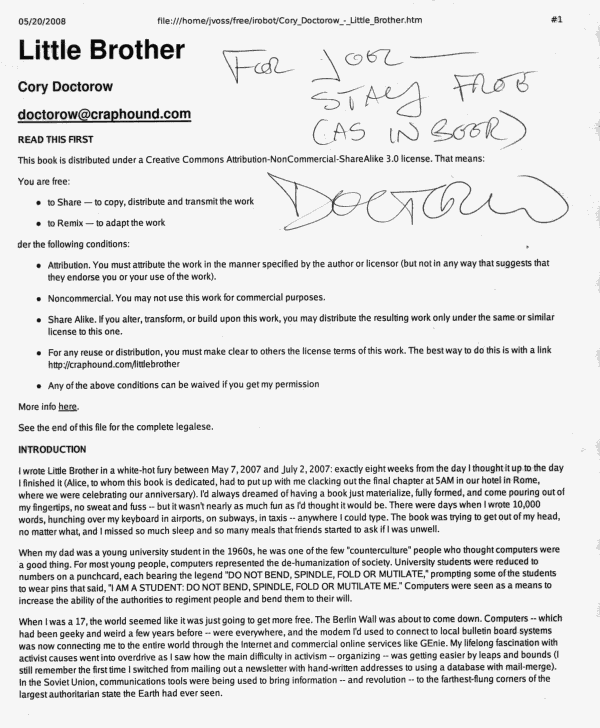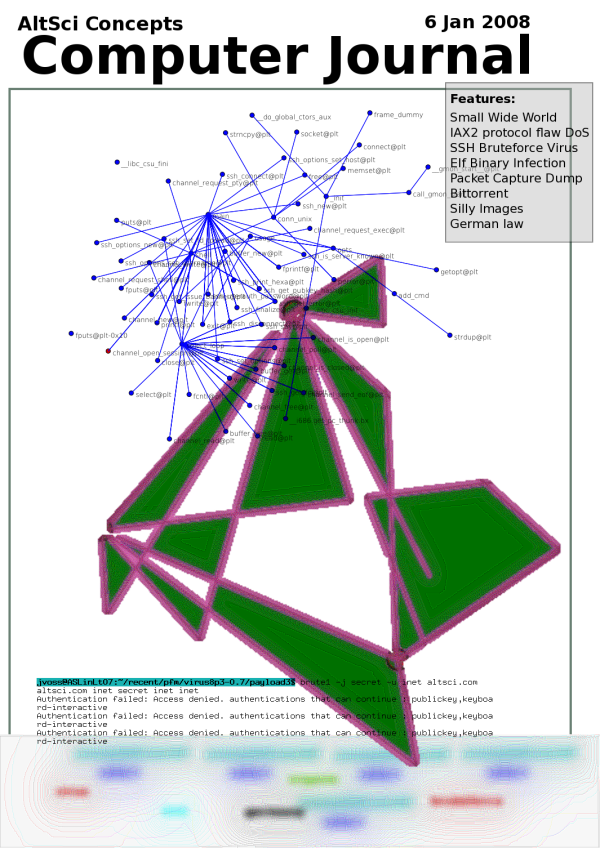by Javantea
May 24, 2008
It seems like automatically generated steganographic-quality images are going to be a regular feature since everyone likes them so well. Today I'll just focus on the algorithm and why it works.

I started with a very non-random image used as an initial seed.

I added another very non-random image for another seed.

I added a fairly random cross hatch image as another initial seed, still not nearly good enough for steganography.

I added a very random hurl (seed 4262833791, 60% random, repeat 11) for an even random seed, almost good enough for steganography, but not good enough for plausible deniability.

Together, this is what they look like:

I then did a gaussian blur radius 50 twice and a sharpen 99:

This is the style that most people recognize as being my style.
I can then change the levels to fit my color and sharpness requirements and did a final blur to ensure the histogram is flatter:

At this point, the image is finished. Why does it work? First of all, a requirement of a steganography-quality image is random seed as seen in picture 4. A random seed alone is not good enough for plausible deniability because no one sends a picture with simple noise (unless they're talking about noise like I am now). The other seeds I added give the picture a very pronounced human texture. This helps with plausible deniability, randomness, and coverage. Adjusting the colors makes the image very pronounced so that a person can claim plausible deniability. This is a valid steganography algorithm because it adds human input, random data, blur, another non-trivial algorithm (sharpen), and a flat histogram with only a few spikes. The important parts of steganography are: anti-brute force, anti-reverse, flat histogram, plausible deniability, and easy generation. This image fits all requirements easily.
Read more »
jvoss@altsci.com
jvoss@myuw.net
April 18, 2008
AltSci IAX2 0.7
[sig]
AltSci IAX2 0.6
[sig]
UPDATE May 24, 2008
I have done a mildly thorough investigation of 1.4.19.1 (the fixed version) and I understand their solution (verify a pseudo-random call number). The solution is as good as I recommended. It does not solve the non-spoofed DoS attack since the attacker can use the call number it receives from the accept packet, but it does make the spoofed DoS attack much less useful (1:5 amplification is practically worthless). I consider this grevious security bug to be fixed. I have not tested backwards compatibility of devices and software versions. I plan to test whether this can be recreated via uncommon use cases such as psuedorandom guessing, sending random commands, etc. I hope that Asterisk will accept my apologies for releasing the exploit before they had a chance to respond. I plan to disclose all future vulnerabilities full disclosure after a timely opportunity for the vendor to respond. I encourage all other security researchers who use my tools to release the vulnerabilities that they find in a similar manner for the benefit of the community.
UPDATE April 24, 2008
Asterisk has responded to the release of my second exploit and framework with a set of patches to SVN. They have made the bug report above publicly available which pleases me. I haven't tested this to make sure that it isn't vulnerable, but I can assure you that I will. I will also spend time to see if their patch is backwards compatible with other versions of Asterisk and soft phones. I applaud Asterisk for their work toward fixing this obvious flaw. Together I believe that we can write and test a good VoIP protocol.
Once in a while a person finds an author who writes enough for a person to really like that author. The ideas that come across are coherent, consistent, and moving. Cory Doctorow is such an author for me. He understands technology, he is brilliant at coming up with plausible futuristic scenarios and he conveys ideas that are as important as anything we will face today. I've met him twice, once at Toorcon San Diego 2006 and once yesterday at a reading. He answered my question quite well. His new book "Little Brother" focuses on a revolution of ideas and values in present day America. He pits students against a tyrannical DHS frighteningly similar to the DHS we know today. He explains with incredible clarity why a war against an abstract noun is invalid and a system designed to protect people from rare events at the cost of their freedom is no more than common tyranny.

My question was: "What brought you to the idea of the probability of rare events and the detectors being useless?" He explained that the problem is that lurid rare events are much less of a threat than common events that harm a person. In his book he explains that trying to find a needle in a haystack is incredibly difficult when the margin of error of detection is so high. Any system designed to trade freedom for really poor results should be rejected.
We live in a country where basic freedoms are being trashed, we are at war with a country who has not attacked us, and the general populous will never revolt against it. We're basically in a downward spiral. With a new president and a possible solution to the war and removal of nationwide wiretaps and institutional torture, we can have hope for a new tomorrow. But persevering and incredible diligence is required still. We cannot afford to allow any screwups to send us back to our downward spiral if we get a chance to fix it. Tell the next president, Mr. Obama that we we're expecting nothing less than a complete change in the way our government is running.
Read more »



